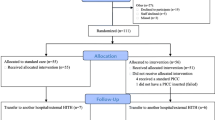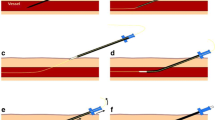Abstract
The primary study objective was to evaluate insertion success rates. Secondary objectives included patient satisfaction, procedure time, complication rates, completion of therapy and dwell time of the novel AccuCath® 2.25″ Blood Control (BC) Catheter System (FDA approved) placed in difficult-access patients. This was a single-arm feasibility trial evaluating the AccuCath® 2.25″ BC Catheter System in a convenience sample of DIVA patients defined as at least two failed initial attempts or a history of difficult access plus the inability to directly visualize or palpate a target vein. All enrolled patients were 18 years of age or older. A total of 120 patients were enrolled. These patients had an average of 3.7 and median of 3 prior attempts at vascular access prior to AccuCath placement. Successful access was gained in 100% of the patients, 77% on the first attempt and all within three attempts; 88.5% of patients completed therapy, with the remaining 12.5% experiencing minor complications that required discontinuation of the catheter. The average patient satisfaction score on a 5-point Likert scale was highly positive at 4.6. Preliminary results show that the AccuCath® 2.25″ BC Catheter System has excellent success rates in gaining vascular access in an extremely difficult patient population. The device did not lead to any significant complications. Patients were also very satisfied with the procedure.

Similar content being viewed by others
References
Dychter S, Gold D, Carson D, Haller M (2012) Intravenous therapy, a review of complication and economic considerations of peripheral access. J Infus Nurs 35(2):84–91
Kokotis K (1999) The role of the IV therapist. JVAD 4:22–27 (winter)
Barton AJ, Danek G, Johns P, Coons M (1998) Improving patient outcomes through CQI: vascular access planning. J Nurs Care Qual 13(2):77–85
Constantino T, Parekh A et al (2005) Ultrasonography-guided peripheral intravenous access versus traditional approaches in patients with difficult intravenous access. Ann Emerg Med 46:456–461
Doniger SJ, Ishimine P et al (2009) Randomized controlled trial of ultrasound-guided peripheral intravenous catheter placement versus traditional techniques in difficult-access pediatric patients. Pediatr Emerg Care 25(3):154–159
Shokoohi H, Boniface K, McCarthy M et al (2013) Ultrasound-guided peripheral intravenous access program is associated with a marked reduction in central venous catheter use in noncritically ill emergency department patients. Ann Emerg Med 61:198–203
Au AK, Rotte MJ et al (2012) Decrease in central venous catheter placement due to use of ultrasound guidance for peripheral intravenous catheters. Am J Emerg Med 30(9):1950–1954
Moon CH, Blehar D et al (2010) Incidence of posterior vessel wall puncture during ultrasound-guided vessel cannulation in a simulated model. Acad Emerg Med 17(10):1138–1141
Panebianco NL, Fredette JM et al (2009) What you see (sonographically) is what you get: vein and patient characteristics associated with successful ultrasound-guided peripheral intravenous placement in patients with difficult access. Acad Emerg Med 16(12):1298–1303
Fields JM, Dean AJ, Panebianco NL et al (2012) The effect of vessel depth, diameter, and location on ultrasound-guided peripheral intravenous catheter longevity. Am J Emerg Med 30(7):1134–1140
Elia F, Ferrari G et al (2012) Standard-length catheters vs long catheters in ultrasound-guided peripheral vein cannulation. Am J Emerg Med 30(5):712–716
Stone MB, Moon C, Sutijono D, Blaivas M (2010) Needle tip visualization during ultrasound- guided vascular access: short-axis vs long- axis approach. Am J Emerg Med 28(3):343–347
Mahler SA, Wang H et al (2010) Ultrasound-guided peripheral intravenous access in the emergency department using a modified Seldinger technique. J Emerg Med 39(3):325–329
Idemoto B, Rowbottom J, Reynolds J, Hickman R (2014) The AccuCath® Intravenous Catheter System with retractable coiled tip guidewire and conventional peripheral intravenous catheters: a prospective, randomized, controlled comparison. J Assoc Vasc Access 19(2):94–102
Kara R, et al. (2016) A modeled health economic analysis of the AccuCath® intravascular catheter system with retractable coiled tip guidewire compared with conventional peripheral intravascular catheters. In: ISPOR 19th annual European congress, poster presentation (October 29–November 2016, Vienna, Austria. Poster published on the Online Value in Health Journal. https://www.ispor.org/ScientificPresentationsDatabase/Presentation/69877?pdfid=47057. Accessed 08 Feb 2017
Author information
Authors and Affiliations
Corresponding author
Ethics declarations
Conflict of interest
The Authors declare that they have no conflict of interest.
Statement of human and animal rights
All procedures performed in studies involving human participants were in accordance with the ethical standards of the institutional and/or national research committee and with the 1964 Helsinki declaration and its later amendments or comparable ethical standards.
Informed consent
Informed consent was obtained from all individual participants included in the study.
Rights and permissions
About this article
Cite this article
Raio, C., Elspermann, R., Kittisarapong, N. et al. A prospective feasibility trial of a novel intravascular catheter system with retractable coiled tip guidewire placed in difficult intravascular access (DIVA) patients in the Emergency Department. Intern Emerg Med 13, 757–764 (2018). https://doi.org/10.1007/s11739-017-1747-0
Received:
Accepted:
Published:
Issue Date:
DOI: https://doi.org/10.1007/s11739-017-1747-0




